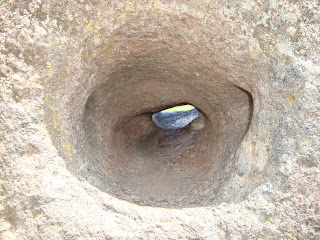 Summary
SummaryThere are indications of transatlantic cultural contacts in Prehistoric Times: Solutrean artifacts (about 20,000 years ago) are found in United States archeological sites and also cave wall inscriptions which may be a early alphabet and are identical all over the World are abundant in southern France and northern Spain. In the present study, close similarities of a Tiwanaku (Titikaka Lake, Bolivia) “ritual ear” and another “ritual ears” observed in Alberite Dolmen (southern Spain, 7,000 years ago) are described. Functionality of these stone carved “ears” is related to amplifying voice and communication between shaman/priest and prayers. Thus, a religious role is put forward for these “ears”, but not excluding other functionalities. In addition, Basque language is considered as a remaining of the initial old Iberian-Tartessian language; Celtic Welsh is now being translated by using Iberian-Tartessian. Iberians identification with Atlantic Celts (British Isles and French Brittany) may be feasible. Also, words of an ancient European language (Basque) and Andean languages are similar in phonology and semantics. Our findings further strengthen the existence of transatlantic cultural contacts, which may have occurred in one direction or being also bidirectional during a wide range of prehistoric time.
Resumen
Existen pruebas de que ha habido contactos culturales transatlánticos en tiempos prehistóricos: se han encontrado restos de la cultura solutrense (establecida hace 20.000 años en Francia y en Iberia) en varios sitios arqueológicos de los Estados Unidos. Así mismo, existen inscripciones rupestres similares de lo que pudiera ser un alfabeto muy temprano, tanto en Estados Unidos, como en Francia-Iberia y en el resto del mundo.
Nosotros hemos encontrado similitudes entre "oídos rituales" de las ruinas de Tiwanaku (Bolivia) y "oídos rituales" del Dolmen de Alberite (construido hace 7.000 años en el sur de España, Villamartín, Cádiz). Estos "oídos rituales" han podido ser utilizados en ambos casos para ceremonias religiosas. Además, la lengua vasca, que es considerada como un remanente de la desaparecida lengua ibérico-tartésica, tiene términos similares en significado y sonido a los de las lenguas andinas. Recientemente se ha propuesto que la lengua ibérico-tartésica es idéntica a algunas lenguas célticas (galés).
Nuestros hallazgos sugieren que efectivamente hubo contactos transatlánticos entre Europa y América, que pudieron ser unidireccionales o bidireccionales. Ref.1 Vease Aquí:
AUDÍFONO
MEGÁFONO
OÍDO HUMANO
PARTE INTERNA DE "OÍDO RITUAL" TIWANAKU
REFERENCIAS
1. Arnaiz-Villena A, Alonso-Rubio J, Ruiz-del-Valle V. Tiwanaku (Titikaka Lake, Bolivia) and Alberite Dolmen (Southern Spain) ritual “ears” Celtic, Iberian, Aymara and Basque languages. Int. J. Mod. Anthrop. 6: 61 - 76 2013. Aquí.








